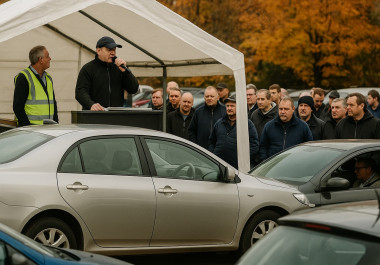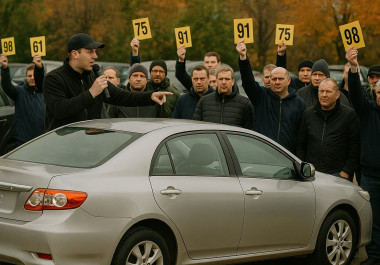Finding a great deal on a vehicle is possible through auctions. The prospect of buying a car through bank repossession car auctions is catching the eye of many smart shoppers for good reason. These events offer a real chance to buy a quality car for a price not typically found elsewhere, attracting everyone from first-time buyers to seasoned mechanics looking for a bargain.
The term "repossession" might sound intimidating, but it simply means the car was returned to a bank when someone could not keep up with their loan payments. The process of buying one is often more straightforward than many think. The following information covers how these auctions work in detail and provides a clear, step-by-step plan for finding a fantastic deal with confidence.
Understanding repossessed cars
To find the best deals, it helps to first understand the journey these cars have taken. A car is repossessed when its owner defaults on their finance agreement. This could be a Hire Purchase (HP) plan, where they would own the car after the final payment, or a Personal Contract Purchase (PCP) plan, which offers more flexibility. In either case, the finance company legally owns the vehicle until the agreement is fully settled.
After several payments are missed and attempts to resolve the debt are unsuccessful, the finance company or bank exercises its legal right to take the car back. Their primary goal is not to make a profit from the sale but to recover the money they are owed as quickly as possible. They are financial institutions, not car dealers, so holding onto a depreciating asset is not in their interest.
This urgency is great news for a buyer. Because lenders want a quick sale, the prices at bank repossession car auctions can be very attractive. The cars are usually sent straight to trusted auction partners, like us at RAW2K. Here, they are sold to the person who makes the highest bid. The whole process is legal and well-regulated. By the time the car is up for auction, it’s ready for a new owner with no leftover finance.
The appeal of repossessed vehicles
The biggest reason people love these auctions is the chance to save significant amounts of money. Lenders are focused on recovering their investment, not on making a large profit. This means starting bids and final sale prices are often much lower than the car's retail price in a showroom. This gives buyers the chance to get a better car than they might have thought they could afford, such as a higher-specification model or a newer vehicle.
The variety of cars is another big plus. One can find everything from a small, practical family car to a sturdy work van or even a luxury SUV. Because people from all walks of life use car finance, the selection is always changing and diverse. A repossessed vehicle could be a nearly-new car that is only a year or two old, offering tremendous value. The car was taken back for financial reasons only, which means the vehicle itself might have been very well looked after by its previous owner.
Knowing the risks: What to look out for
While a bargain can be found, it’s important to be realistic about the risks. The condition of a repossessed car can be a mixed bag. Some cars are in perfect shape with a complete service history. Others might have been neglected by an owner who was struggling with money.
Here are some common issues to keep in mind:
-
Deferred Maintenance: The previous owner might have skipped regular services like oil changes, brake fluid replacement, or other needed repairs. This is common when financial difficulties arise.
-
Missing Paperwork: Important documents like the service book, spare keys, or the V5C logbook (the car's registration document) could be missing. A new V5C can be applied for, but not having it at the auction means the number of previous owners cannot be confirmed.
-
General Wear and Tear: Buyers should expect normal signs of use. However, they should also be prepared for some cosmetic damage, such as scuffed alloys or supermarket trolley dings, or an interior that needs a good clean.
Buying at auction is a trade-off. A lower price is offered in exchange for a bit more uncertainty. This is why inspecting the car carefully is the most important thing a buyer can do.
Your step-by-step guide to finding a great deal
To succeed at bank repossession car auctions, a clear plan is needed. Following these steps will help in finding a great vehicle and avoiding common mistakes.
Step 1: Find the right auctions
First, one must find where these sales are happening. Many finance companies work with specific auction houses. A great place to begin the search is right here on our listings at RAW2K. We work with many different sellers to offer a huge range of vehicles, including repossessed cars. It is a good idea to set up alerts for specific makes or models you are interested in.
As you search, it's a good idea to look at other types of auctions too. Think about looking into government vehicle auctions, where old fleet cars from councils or public services are sold. One could also check out police seized vehicles. These auctions also offer cars at low prices, but the history and condition of these vehicles can be even more varied and they may have been involved in criminal activity.
Step 2: Do your homework before you bid
Never bid on a car without researching it first. Once a car of interest is found, the homework should start right away.
-
Know the Car's Worth: Look online to see what the same model with a similar age and mileage sells for. Check dealer prices, private sale prices, and other auction results. This helps in understanding the car's true market value, so a good deal can be recognised.
-
Get a History Check: If the car's registration number is available, it's worth paying for a full history check online. This report can reveal if the car has ever been stolen, written off by an insurance company, has mileage discrepancies, or has other hidden issues.
-
Learn About Common Problems: Every car model has its own common faults. A quick search online in owner forums or enthusiast groups can reveal what to look for on the specific model. This knowledge will be very powerful during an inspection.
Step 3: Plan your budget carefully
A budget is much more than just the final bid. It's easy to forget the extra costs involved.
-
The Hammer Price: This is the price of the winning bid.
-
Buyer’s Premium: This is a fee paid to the auction house. It's usually a percentage of the hammer price plus VAT.
-
VAT: Check if you need to pay VAT (Value Added Tax) on the car or the premium. This is especially important for commercial vehicles.
-
Getting it Home: If the auction isn't nearby, the cost of picking the car up, either by driving it (if legal) or having it transported, will need to be factored in.
-
Immediate Repairs: It's smart to have a fund ready for an oil change, a full service, and any small repairs the car might need right away. A good rule of thumb is to set aside 10-20% of what was paid for the car. This could cover new tyres, brake pads, or other essentials.
Step 4: The importance of a full inspection
If the auction house has a viewing day, it must be attended. It is the most important step in the entire process.
-
Check the Outside: Walk around the car slowly. Look for gaps between the body panels that look uneven. Check for paint that doesn’t quite match in colour or texture. These are signs of a past accident. Also, check the tyres for good tread and even wear. Mismatched budget tyres can be a sign of a car that has been run on a tight budget.
-
Examine the Inside: Get in the car. Turn the key in the ignition and check for any warning lights on the dashboard. Test all the electronics. This includes the windows, lights, wipers, air conditioning, and radio. Sniff for any damp smells, which could mean there is a leak, or signs of a smoker or pet owner.
-
Look Under the Bonnet: You don't need to be a mechanic to do some basic checks. Look at the oil level and its colour on the dipstick. Check the coolant level. Look for a creamy substance in the coolant or on the oil filler cap, which could signal a serious engine problem.
-
Bring a Friend: If you’re not confident about checking cars, ask a friend who knows about mechanics to come with you. A second pair of eyes can spot things you might miss.
Step 5: Bidding with a smart strategy
The excitement of an auction can make people overspend. This is often called "auction fever."
-
Stick to Your Limit: A maximum budget was decided on for a reason. Stick to it. Do not be tempted to go higher, even if it's just for one more bid. It is better to miss out on one car than to overpay.
-
Bid with Confidence: When you do bid, do it clearly and confidently. If you seem hesitant, other bidders might think you are already at your limit and may try to outbid you.
-
Be Ready to Walk Away: This is the most important tip. There will always be another auction and another car. If the bidding goes past your limit, the smartest thing you can do is stop.
To join our auctions, you’ll need an account. It’s easy to sign up on our Register page. If you have any questions, our team is happy to help. Just contact us.
Conclusion: A world of deals for prepared buyers
Bank repossession car auctions are a fantastic way to buy a vehicle for much less than you would pay at a dealership. Success isn't about luck. It's about good research, careful inspection, and smart, disciplined bidding. When you understand how the process works and what to look out for, you can approach these sales with ease. One can avoid the common traps and find a truly great deal. With the advice here, you are now ready to find a great car and enjoy the satisfaction of a job well done. For all the latest news and fresh auction listings, be sure to check our News section.




